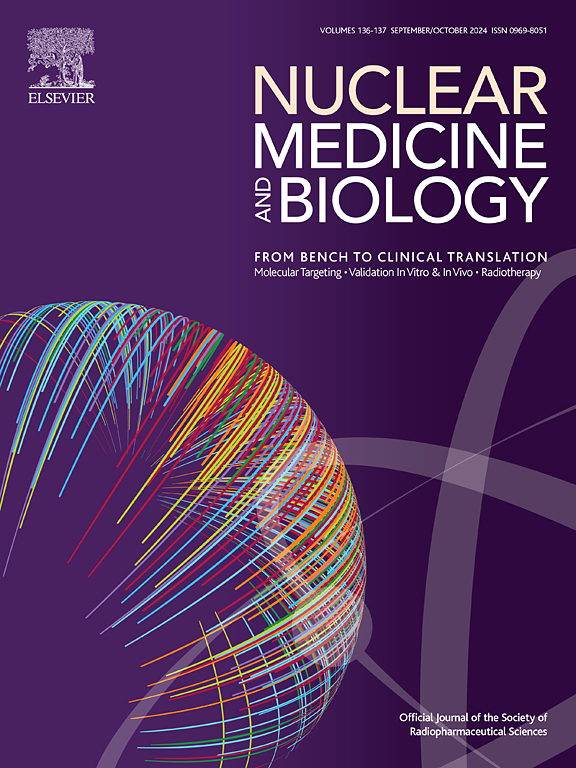对市售模块进行改造,用于生产供人类使用的α -[11C]甲基- l-色氨酸([11C]AMT)
IF 3.6
4区 医学
Q1 RADIOLOGY, NUCLEAR MEDICINE & MEDICAL IMAGING
引用次数: 0
摘要
α -[11C]甲基- l-色氨酸([11C]AMT)的复杂放射性合成涉及苛刻的化学物质和条件,对其在商业合成模块上的实施提出了挑战。本研究描述了GE TRACERlab FX2 C模块对[11C]AMT生产的适应性,采用半手动方法和半自动化方法(包含16路阀系统)。[11C]AMT合成的衰变校正放射化学产率为13±7.5%(半人工)和10.4±4.1%(半自动化),放射化学纯度超过95%。半人工方法在合成成功方面表现出更高的可靠性,但需要更多的操作人员干预,而半自动方法最大限度地减少了操作人员的辐射暴露。影响合成成功的关键因素包括二异丙酰胺锂的制备和精确添加,以及在[11C]CH3I转移过程中使用钠石灰柱减轻碘污染。这项工作提出了一种实用且可扩展的解决方案,用于在商用模块上生产[11C]AMT,使其在临床研究中得到更广泛的应用,特别是在脑成像和儿科肿瘤学方面。本文章由计算机程序翻译,如有差异,请以英文原文为准。
![Adaptation of a commercially available module for the production of alpha-[11C]methyl-L-tryptophan ([11C]AMT) for human use](https://img.booksci.cn/booksciimg/2025-4/102303287021777195427.jpg)
Adaptation of a commercially available module for the production of alpha-[11C]methyl-L-tryptophan ([11C]AMT) for human use
The complex radiosynthesis of alpha-[11C]methyl-L-tryptophan ([11C]AMT) involves harsh chemicals and conditions, posing challenges for its implementation on commercially available synthesis modules. This study describes the adaptation of the GE TRACERlab FX2 C module for [11C]AMT production using both a half-manual approach and a semi-automated method incorporating a 16-way valve system.
[11C]AMT was synthesized with decay-corrected radiochemical yields of 13 ± 7.5 % (half-manual) and 10.4 ± 4.1 % (semi-automated), with radiochemical purities exceeding 95 %. The half-manual approach demonstrated higher reliability in synthesis success but required increased operator intervention, while the semi-automated method minimized radiation exposure to the operator. Key factors influencing synthesis success included the preparation and precise addition of lithium diisopropylamide and the use of a soda lime column to mitigate iodine contamination during [11C]CH3I transfer.
This work presents a practical and scalable solution for producing [11C]AMT on a commercially available module, enabling its broader application in clinical research, particularly in brain imaging and pediatric oncology.
求助全文
通过发布文献求助,成功后即可免费获取论文全文。
去求助
来源期刊

Nuclear medicine and biology
医学-核医学
CiteScore
6.00
自引率
9.70%
发文量
479
审稿时长
51 days
期刊介绍:
Nuclear Medicine and Biology publishes original research addressing all aspects of radiopharmaceutical science: synthesis, in vitro and ex vivo studies, in vivo biodistribution by dissection or imaging, radiopharmacology, radiopharmacy, and translational clinical studies of new targeted radiotracers. The importance of the target to an unmet clinical need should be the first consideration. If the synthesis of a new radiopharmaceutical is submitted without in vitro or in vivo data, then the uniqueness of the chemistry must be emphasized.
These multidisciplinary studies should validate the mechanism of localization whether the probe is based on binding to a receptor, enzyme, tumor antigen, or another well-defined target. The studies should be aimed at evaluating how the chemical and radiopharmaceutical properties affect pharmacokinetics, pharmacodynamics, or therapeutic efficacy. Ideally, the study would address the sensitivity of the probe to changes in disease or treatment, although studies validating mechanism alone are acceptable. Radiopharmacy practice, addressing the issues of preparation, automation, quality control, dispensing, and regulations applicable to qualification and administration of radiopharmaceuticals to humans, is an important aspect of the developmental process, but only if the study has a significant impact on the field.
Contributions on the subject of therapeutic radiopharmaceuticals also are appropriate provided that the specificity of labeled compound localization and therapeutic effect have been addressed.
 求助内容:
求助内容: 应助结果提醒方式:
应助结果提醒方式:


